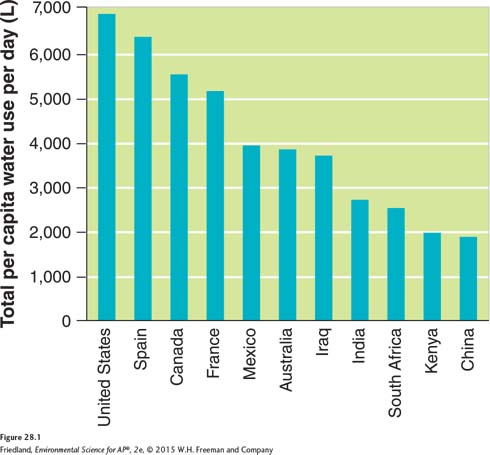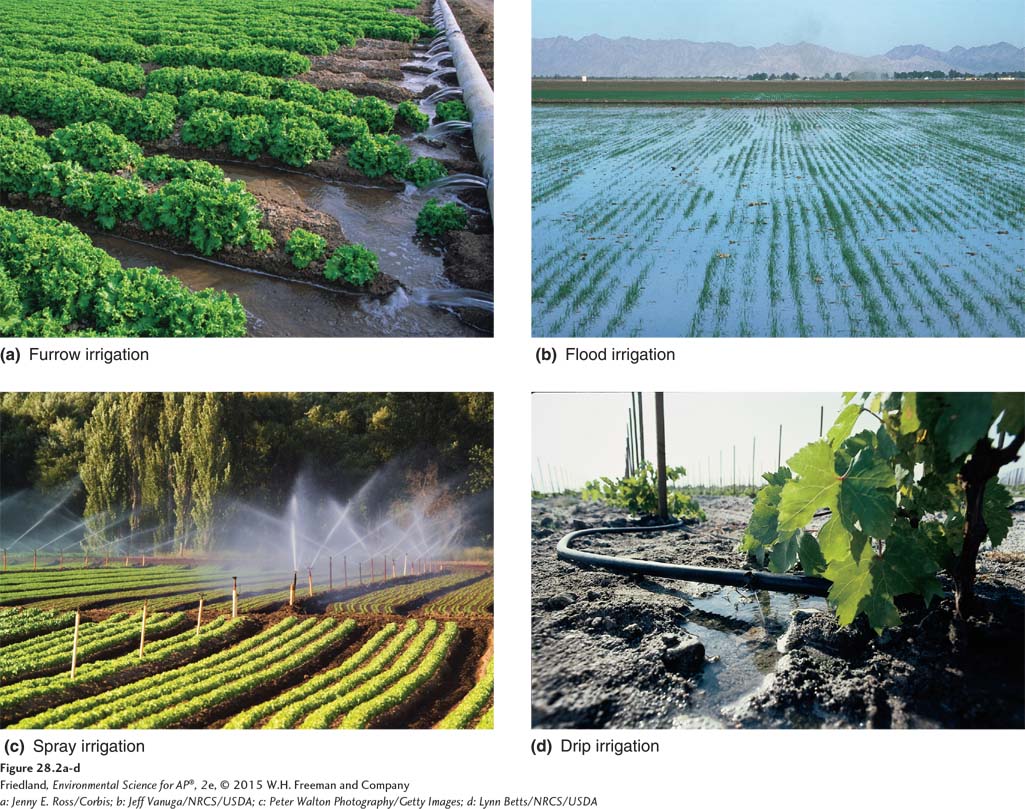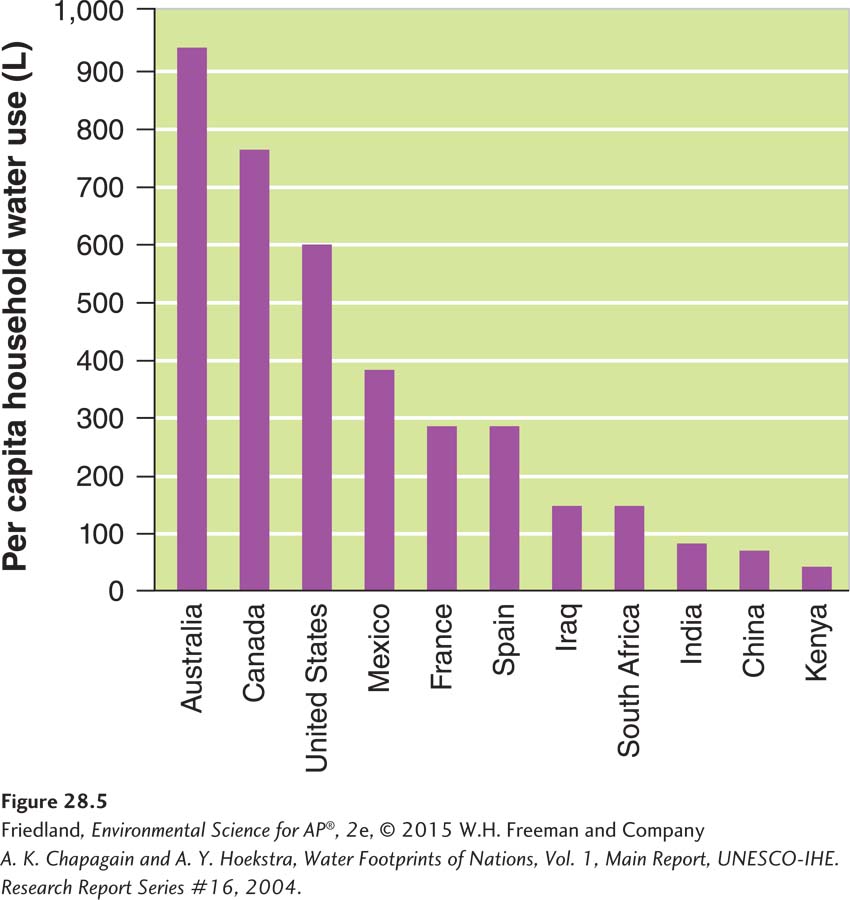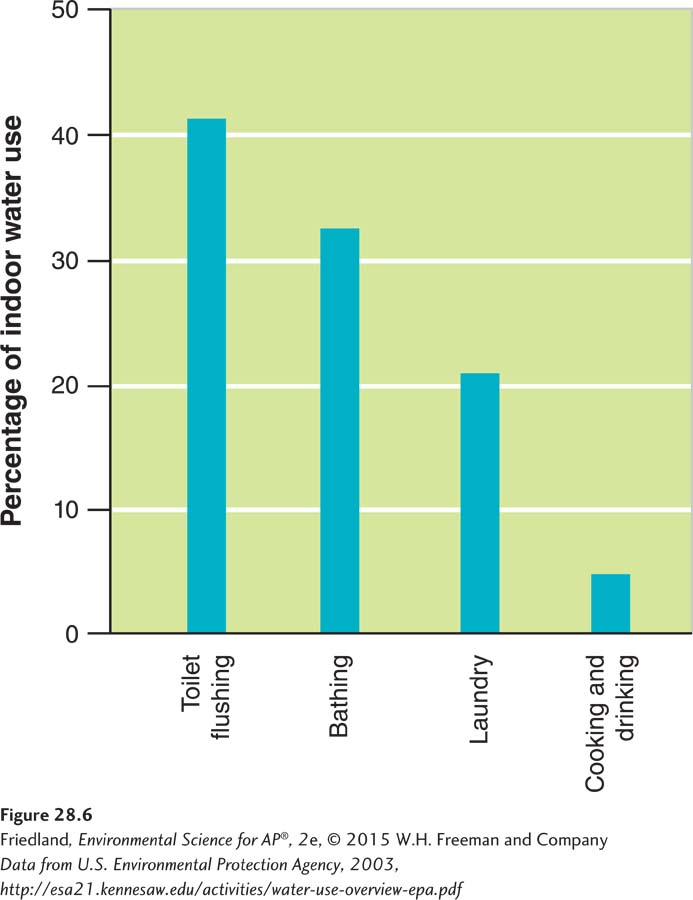module 28 Human Use of Water Now and in the Future
308
A human can survive without food for 3 weeks or more, but cannot survive without water for more than a few days. Water is also essential for producing food. In fact, 70 percent of the world’s freshwater consumption is used for agriculture. The remaining 30 percent is split between industrial and household uses, the proportion of which varies from country to country. On average, experts estimate that about 20 percent of the world’s freshwater use is for industry and about 10 percent is for household uses. In this module, we will examine the major uses of water by humans in the areas of agriculture, industry, and households. We will then investigate how water ownership and conservation will determine the availability of water in the future.
Learning Objectives
After reading this module you should be able to
compare and contrast the four methods of agricultural irrigation.
describe the major industrial and household uses of water.
discuss how water ownership and water conservation are important in determining future water availability.
Water is used for agriculture
Water footprint The total daily per capita use of fresh water.

As we have seen with so many other resources, the per capita daily use of water varies dramatically among the nations of the world. FIGURE 28.1 shows total daily per capita use of fresh water for a number of countries, which is known as the water footprint of a nation. This water use reflects the total water use by a country for agriculture, industry, and residences divided by the population of that country. This allows us to compare water use among nations. For example, a person living in the United States, Spain, or Canada uses about three times more water than a person living in Kenya or China.
As we have just noted, the largest use of water worldwide is for agriculture. During the last 50 years, as agricultural output has grown along with the human population, the amount of water used for irrigation throughout the world has more than doubled. Indeed, producing a metric ton of grain (1,000 kg, or 2,200 pounds) requires more than 1 million liters of water (264,000 gallons). Together, India, China, the United States, and Pakistan account for more than half the irrigated land in the world. In the United States, approximately one-
309
Irrigation
Since agriculture is the greatest consumer of fresh water throughout the world, agriculture poses a large potential for conserving water. One way to conserve water in agriculture is by changing irrigation practices. There are four major techniques for irrigating crops: furrow irrigation, flood irrigation, spray irrigation, and drip irrigation (FIGURE 28.2).

The oldest technique is furrow irrigation (FIGURE 28.2a), which is easy and inexpensive. The farmer digs trenches, or furrows, along the crop rows and fills them with water, which seeps into the ground and provides moisture to plant roots. Furrow irrigation is about 65 percent efficient; 65 percent of the water is accessible to the plants and the other 35 percent either runs off the field or evaporates.
310
Flood irrigation (FIGURE 28.2b) involves flooding an entire field with water and letting the water soak in evenly. This technique is generally more disruptive to plant growth than furrow irrigation, but is also slightly more efficient, ranging from 70 to 80 percent efficiency. In spray irrigation (FIGURE 28.2c), water is pumped from a well into an apparatus that contains a series of spray nozzles that spray water across the field, like giant lawn sprinklers. The advantage of spray irrigation is that it is 75 to 95 percent efficient, but it is also more expensive than furrow or flood irrigation and uses a fair amount of energy.
The most efficient method of irrigation, drip irrigation (FIGURE 28.2d), uses a slowly dripping hose that is either laid on the ground or buried beneath the soil. Drip irrigation using buried hoses is over 95 percent efficient. It has the added benefit of reducing weed growth because the surface soil remains dry, which discourages weed germination. Drip irrigation systems are particularly useful in fields containing perennial crops such as orchard trees, where the hoses do not have to be moved each year in order to plow the field.

Efficient irrigation technology benefits the environment by reducing both water consumption and the amount of energy needed to deliver the water. Many new technologies are being developed to more carefully control when plants are irrigated. As with all human activities, the costs and benefits of each irrigation technique need to be weighed to determine the best solution for each situation.
Hydroponic Agriculture
Hydroponic agriculture The cultivation of plants in greenhouse conditions by immersing roots in a nutrient-
For some crops, hydroponic agriculture is an alternative to traditional irrigation. Hydroponic agriculture is the cultivation of crop plants under greenhouse conditions with their roots immersed in a nutrient-
Water is also used for industrial processes and households
While most water is used for agriculture, the remainder is used for industrial purposes and households.
Industrial Water Use
Water is required for many industrial processes, such as generating electricity, cooling machinery, and refining metals and paper. In the United States, approximately one-

Some processes that generate electricity do consume water. This means that some of the water used is not returned to the source from which it was removed, but instead enters the atmosphere as water vapor. Thermoelectric power plants, including the many plants that generate heat using coal or nuclear reactors, are large consumers of water. These plants use heat to convert water into steam that is used to turn turbines. The steam needs to be cooled and condensed before it can be returned to its source. In many plants, this cooling is accomplished by using massive cooling towers. If you have ever seen a nuclear power plant, even from a distance, you may have seen the large plumes of water vapor rising up for thousands of meters from the cooling towers. The towers allow much of the steam from the plant to condense and cool into liquid water, but a large fraction of it is lost to the atmosphere. This water vapor represents the water that is consumed by nuclear reactors (FIGURE 28.4).

311
Industrial processes such as refining metals and making paper also require large amounts of water. Copper, used extensively for electrical wiring, requires 440 L (116 gallons) of water per kilogram to refine. Aluminum, used in products as diverse as automobiles and aluminum foil for cooking, requires 410 L (108 gallons) per kilogram. Steel, used to manufacture home appliances, cars, buildings, and other products, requires 260 L (68 gallons) per kilogram. When we use paper, we indirectly use water. A kilogram of paper requires 125 L (33 gallons) of water to manufacture. As we will see later in this chapter, there are opportunities to reduce the use of water during these processes.

Household Water Use
According to the U.S. Geological Survey, household use accounts for approximately 10 percent of all water used in the United States. The quantity of water used in households depends on the types of infrastructure available. Households in less developed countries generally do not have the appliances and bathroom fixtures that are common in more developed countries. As a result of such disparities, per capita household water use varies dramatically among nations. For example, on average, an individual in the United States uses 595 L (157 gallons) per day, whereas an average individual in Kenya uses only 41 L (11 gallons) per day. FIGURE 28.5 shows per capita daily household water use for the United States and 10 other countries.
Indoor use of water is quite similar across the United States since households across the country are typically equipped with bathrooms, washing machines, and cooking appliances. FIGURE 28.6 shows the fraction of indoor water use that goes to each of these functions. Of all household water that is used indoors, 41 percent is used for flushing toilets, 33 percent for bathing, 21 percent for laundry, and 5 percent for cooking and drinking.
Outdoor water use—
312
Although drinking water represents a relatively small percentage of household water use, it is particularly important. If you live in a developed country, you may not have given much thought to the availability and safety of drinking water. However, more than 1 billion people—
The future availability of water depends on water ownership and water conservation
The future of water availability will depend on many things, including how we resolve issues of water ownership, how we improve water conservation, and—
Water Ownership
Water is an essential resource, but who actually owns it? This is a rather complex question. In a particular area, such as the Klamath River region described at the beginning of the chapter, it is clear that multiple interest groups can claim a right to use and consume the water. However, having a right to use the water is not the same as owning it. For example, regional and national governments often set priorities for water distribution, but of course they have no control over whether or not a particular year will bring an abundance of rain and snow. In California, the state government promises specific amounts of water for cities, suburbs, farmers, and fish, but these promises can exceed the actual amount of water that is available in many years.

Throughout the world, the issues of water rights and ownership have created many conflicts. Earlier in this chapter we discussed India’s plan to divert water from rivers that flow from the Himalayas into Bangladesh (FIGURE 28.7). Since the water originates in India, does India own the water? Does Bangladesh have any legitimate claim to some of this water that its people have relied on for millennia? In the water-
313
One solution that has been proposed by economists is to allow all interested parties to openly compete for water and let market forces determine its price. In this way, they argue, water could be owned, but the true value of water would be realized and paid for. In 1981, a free-
Water Conservation
Ultimately, there is a finite amount of water that we all must share. In some regions, such as much of the northeastern United States, water is abundant. In regions where water is scarce, such as the southwestern United States, water conservation becomes more of a necessity.
In recent years, many countries have begun to find ways to use water more efficiently through technological improvements in water fixtures, faucets, and washing machines. In 1994, new federal standards were issued for toilets and showerheads in the United States. For example, a toilet manufactured before 1994 typically uses 27 L (7 gallons) per flush, but toilets manufactured after January 1994 must use 6 L (1.6 gallons) or less per flush, representing a 78 percent reduction in water use. Australia and some countries in Europe and Asia have moved to dual-
In countries where a percentage of the population can be considered wealthy, household water uses can include watering lawns and filling swimming pools, both of which require large amounts of water. In some regions of the United States, homeowners have been encouraged, or even required, to plant vegetation that is appropriate to the local habitat. For example, the city of Las Vegas, Nevada, paid homeowners to remove water-

One of the best ways to reduce industrial water consumption is by producing more efficient manufacturing equipment. In the United States, businesses and factories have achieved more sustainable water use in the last 15 years, mainly through the introduction of equipment that either uses less water or reuses water. For example, industries that need water for cooling machinery have switched from once-
314

Some simple ways to conserve water can be used throughout the world. For example, the impervious surfaces of buildings represent a potential water-
The world’s growing population and the associated expansion of irrigated agriculture have increased global water withdrawals more than fivefold in the last hundred years. Global water use is expected to continue to grow along with the human population through the early part of this century. However, as FIGURE 28.9 shows, despite the growing population in the United States, water withdrawals have leveled off since they peaked in 1980. This is largely a result of greater efficiency in the use of water for agricultural irrigation, electricity generation, and household appliances. Reductions in water use are projected to continue until at least 2020. Of course, the continued development of more efficient technologies would allow additional reductions in water use.